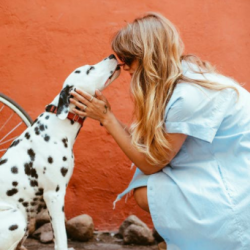
While the notion of a scared dog can be terribly scary, a scared dog is one that needs to be handled with care. A scared dog can lash out and bite but in most cases the dog will largely respond to motivation and not fear. It is very easy for a scared dog to lash out but it is far more advisable to discover the reason for its fear and begin steps to counteract the fear with a calm but firm hand.
It is very important to examine the dog carefully and try and ascertain whether there is anything which could lead to the animal feeling threatened. A scared dog is unlikely to attack but may bite out of fear so will need to be treated in a manner that does not put the dog in a position to bite. A dog that is already in a highly vocal state may be more prone to biting. A dog that is running at you in fear may not have the resolve or common sense to respond to your commands. All such things need to be taken into account when training a dog.
Training a frightened dog can be a daunting task but with a little persistence can be accomplished. One of the first tasks the trainer has to master is getting the dog to spend more time in the pen. This should ideally begin when the dog is a puppy but can even turn into a more adult task with training. Dogs should be praised and patted when they are doing something right. A small puddle of drool on your cheek or a gentle rub on the back is a good way of communicating approval. It is very important that a dog is able to associate such rewards with good behavior so begin rewarding hesitancy to jumping up.
For adults a stern “NO” is enough to stop a dog in their tracks but for a puppy it’s even more important. The dog must learn there are consequences for a negative behavior. A fearful dog may bite someone thinking it is the only way to protect itself from harm but as the dog grows it will learn biting is not the answer. For example I was doing a pre purchase inspection on a car I was purchasing and my puppy kept jumping into the driver’s seat. A stern, “No,” got him to jump out and sit by the car patiently. A human’s voice is the dog’s primary way of communicating so it is important the owner will speak to the dog cautiously and sternly. A friendly firm “NO” will get the message across in the dog’s language and should the dog not obey, a severe “STOP” will do the trick.
A fearful dog may bite out of fear not aggression. Fearful dogs may be triggered by a lot of circumstances, such as a child taunting the dog or provoke it without knowing. This is why it is so important to start training the dog from a young age. The earlier you start training a fearful dog the easier it will be.
A dog that is cold, frightened or stressed may become hot, snap, bite or lose control. Blue from humans can also be damaging for dogs. There are vitamins available to help heal broken skin caused by blue, scratched skin, however care must be taken not to scratch the area raw.
Barking is how a dog communicates. A dog may bark for a variety of reasons, for attention, to intimidate another dog or other animal and as a warning. A dog’s bark is a warning that up to 10,000 years has been passed. It is the dog’s way of keeping in contact and of announcing that it is on the move. A dog that cannot bark should be left alone for the time being.
Growling and snapping are displays of dominance the dog is using to assert itself as alpha. The dog will raise its hackles and position itself to make itself look bigger. A dog’s eyes become a dark color and its ears are standing erect. The dog looks like it is ready to attack. A growl is a warning not to hurt or attack its master. A dog will also growl to attract attention. If a child is behaving submissively and is not barking or growling aggressively, a dog will again attempt to snap at it.
A dog will also growl to prevent being attacked. Submissive behavior will often include a head tilt and a pleading posture. This will include whining. A dog may also growl to show that it is injured or distressed such as when it is being approached by another dog and is crouching, for example.
Waving its tail slowly and stiffly is a posture of submission, a show of discomfort or pain. A dog will wag its tail slowly in the same direction as its head and has the hair along the back fallen out on its back.
When a dog is frightened, its ears will be drawn forward and its eyes will narrow. If a dog is agitated, its ears will point forward. Its eyes will be focused on a single spot and its pupils will be dark. If a dog is showing aggression, its ears will point forward and its eyes will be narrowed. Its eyes will be dark, round and dilated. Its tail will be slowly wagging.

